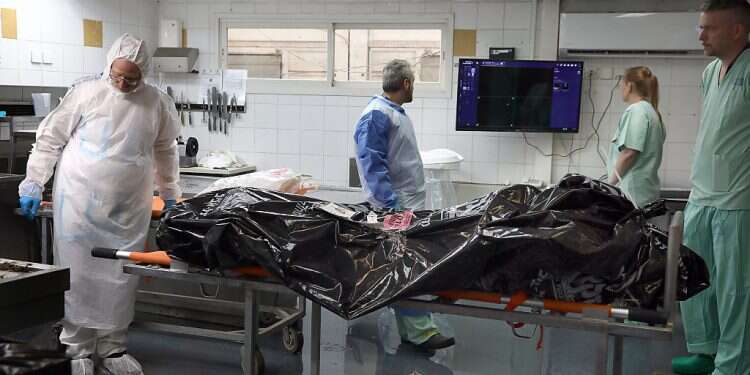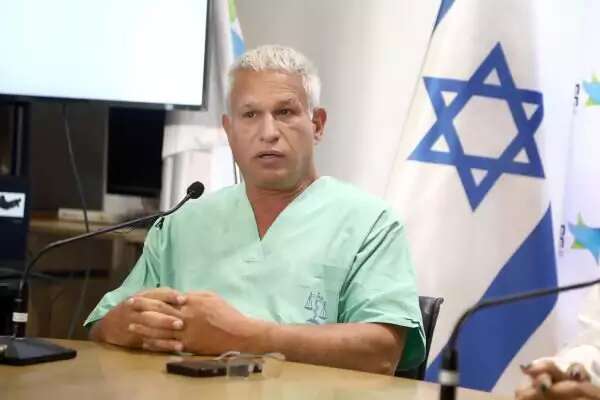'A CT scan revealed the horrifying truth: 2 spines – an adult and a young child, bound in thick wire'
The head of the National Institute of Forensic Medicine speaks with Israel Hayom. More than 100 bodies remain unidentified. It attests to the intensity of the abuse that these people went through: Mostly it was the torching of their homes, in some cases generating more than 700°C of heat and making it effectively impossible to extract DNA from the body. The problem is that many of those murdered were children who had no medical history.
Yoav Limor
Israel Hayom
Oct 24, 2023
 Medical examiners with a body at the Israel National Center of Forensic Medicine
Medical examiners with a body at the Israel National Center of Forensic Medicine
A hunk of charcoal that was suspected of being composed of human bone, found in one of the houses on the Gaza border towns, reached the National Institute of Forensic Medicine. A CT scan revealed the horrifying truth: it was two spinal columns, one of an adult man and the other of a young child, bound in thick wire – evidently a father and his son, tied up while embracing and set ablaze until totally cremated.
These photos are included in a presentation that the director, Prof. Chen Kugel, put together in order to show his colleagues abroad a few of the atrocities that the inhabitants of the Gaza periphery had gone through. The presentation is hard to watch even for those who thought they'd seen everything. The impression of it persists for hours; the thought of what these people endured on the morning of Oct. 7 cannot be absorbed and comprehended.
A tremendous professional challenge
Kugel showed me the presentation after I asked him how so many people remain unidentified two weeks after the incident. "We identified 800 people within two weeks. That's an insane achievement," he said. "That amount of work usually takes months. It took the Americans more than a year to identify those killed in 9/11 and some have not been identified to this day."

Prof. Chen Kugel
Kugel believed from the first moment that the conventional way of doing things was problematic. In principle, it's done one at a time: you open each body bag, photograph the body and the teeth, and take fingerprints – a process that takes about an hour. "To make it more efficient, we switched to an across-the-board working method. First of all, we took DNA from all the bodies; that way we managed to speed up the process." The institute also went over to shift work in order to speed up the identification process.
Even so, more than 100 bodies remain unidentified. It attests to the intensity of the abuse that these people went through: Mostly it was the torching of their homes, in some cases generating more than 700°C of heat and making it effectively impossible to extract DNA from the body. In one house, bones were gathered into a bag and delivered to the institute. In their CT scan, they were found to be three left legs and two right legs – the remains of at least three people.
In an attempt to identify additional bodies, the institute uses every possible scrap of information. X-rays and dental records of all missing persons were gathered from all hospitals and clinics countrywide. Radiologists and computer experts tried to match the X-rays of the bodies (often, body parts) with images that exist in the system. The problem is that many of those murdered were children who had no medical history, as well as foreign workers and even terrorists whose bodies apparently mingled with those gathered up in the field.
Immediately after the magnitude of the disaster became known, Kugel contacted his colleagues abroad and asked them to fly to Israel in order to help. When I asked him why Israel couldn't take care of it on its own, he replied with a despondent smile. "You know how many medical experts there are in this country?" he asked, and quickly answered: "Seven. And you know how many the personnel standard says there ought to be?" I ventured a wild guess. "Ninety," he replied.
Experts from the United States, New Zealand, and Switzerland flew in to help Kugel and his staff. I encountered one of the Swiss doctors and wondered what she was going through. She had come from Geneva and said that what happened here was unprecedented: "I've never seen such things." Her testimonies and those of her colleagues may help Israel in future legal claims against Hamas and its supporters.
Some of those who reached Israel were expert anthropologists who tried to help identify bodies on the basis of the age and nature of the bones. In one of the rooms at the institute, they assemble, literally assemble, pieces of bones that were collected in the field into a complete skeleton in an attempt to make identification possible. "It's an enormous professional challenge," Kugel says. "I'm afraid there will be people whom we won't manage to identify. We'll never know what happened to them; the state will have to declare them casualties whose place of burial is unknown."
Kugel and his staff often have to decide whether a person died on the basis of a bone fragment found in the field. In these cases, an attempt is made to return to the scene – the house or the place where the evidence was found – in an attempt to collect additional evidence that would support the conclusion. "The more time passes, the fewer missing persons there are because we identify more and more people. But in contrast, with each passing day it gets harder to extract DNA in order to establish someone's identity."
"Wholesale executions"
Kugel says that he's been in this profession for thirty-one years but nothing prepared him for this. "I've seen people who were shot, who were burned, but not the way they did and for sure not on such a scale." His presentation abounds with examples: masses of people who were bound in every possible way (with electric wire, barbed wire, plastic ties, or pieces of clothing) and then shot, cremated, or both. "There were wholesale executions from point-blank range, including of children," he says.
Being experienced in this kind of work does not inure a person to such sights, especially since everything here is personal. Dr. Nurit Bublil, the institute's director of laboratories, tells of employees of the institute who knew people who were missing and had to work in the almost inhuman expectation of identifying their loved ones. She herself is too busy at work to watch the news, but in her case the atrocity sits in her hands.
"The magnitude of what happened, the numbers, are just endless," she
says. "Whenever I manage to come up for air as I work, I can't help
imagining the inferno."
No comments:
Post a Comment